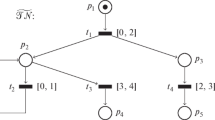Abstract
It is our belief that the formal design of real-world concurrent systems does not fit well with model/state-oriented specification languages such as the Z notation. The problem with such systems is that they not only expose complex functional requirements but also critical control-level aspects such as concurrency. On the other hand, the most widely-spread formal languages dealing with concurrency, namely Petri-nets, reveal weaknesses (mostly state-space explosion) when dealing with complex functional requirements. In this paper, we propose a hybrid methodology, based on the traditional Z notation for the functional part of the system and using Petri-nets to model its concurrent control. We describe a simple method to derive new proof obligations in case of possible concurrent activation of Z operations, as modeled by the associated Petri-nets. By keeping the interface between both worlds as thin as possible, we do not put into question the interesting properties of the Z language: expressiveness, modularity and support for refinement. Moreover, our petri-based concurrent activation networks only address concurrency issues. Hence, it is likely that they remain manageable in term of state-space and so analyzable using existing Petri-net tools. We experimented this exploratory method on a real application, a research middleware kernel, which is now fully operational.
This work is supported by the Japan Society for the Promotion of Science (JSPS) under research grand #14-02748.
Access this chapter
Tax calculation will be finalised at checkout
Purchases are for personal use only
Preview
Unable to display preview. Download preview PDF.
Similar content being viewed by others
References
G. Agha. Actors: A Model of Concurrent Computation in Distributed Systems. Series in Artificial Intelligence. MIT Press, 1986.
J.-P. Briot. Actalk: a Testbed for Classifying and Designing Actor Languages in the Smalltalk-80 Environment. In S. Cook, editor, Proceedings of ECOOP’89, pages 109–129. Cambridge University Press, July 1989.
C. Fischer. How to combine z with a process algebra. In Proceedings of ZUM’98, volume LNCS 1493. Springer-Verlag, September 1998.
M. Heiner. Petri net based system analysis without state explosion. In Proceedings of High Performance Computing’98, April 1998.
M. Heiner and M. Heisel. Modeling safety-critical systems with z and petri-nets. In Proceedings of Computer Safety, Reliability and Security, volume LNCS 1698. Springer-Verlag, 1999.
B. Mahony and J. S. Dong. Timed communicating object z. IEEE Transactions on Software Engineering, 26(2):150–177, 2000.
R. F. Paige. Specification and refinement using a heterogeneous notation for concurrency and communication. Technical report, York University, October 1998.
F. Peschanski. A reflective middleware architecture for adaptive, component-based disitrubted systems. IEEE DS Online, 1(7), 2001.
F. Peschanski. A versatile event-based communication model for generic distributed interactions. In Proceedings of DEBS’02 (ICDCS International Workshop on Distributed Event-based Systems). IEEE, July 2002.
J. L. Peterson. Petri Net Theory and the Modeling of Systems. Prentice-Hall, 1981.
J. M. Spivey. The Z Notation: a reference manual. http://spivey.oriel.ox.ac.uk/~mike/zrm/, 2001.
Author information
Authors and Affiliations
Editor information
Editors and Affiliations
Rights and permissions
Copyright information
© 2003 Springer-Verlag Berlin Heidelberg
About this paper
Cite this paper
Peschanski, F., Julien, D. (2003). When Concurrent Control Meets Functional Requirements, or Z + Petri-Nets. In: Bert, D., Bowen, J.P., King, S., Waldén, M. (eds) ZB 2003: Formal Specification and Development in Z and B. ZB 2003. Lecture Notes in Computer Science, vol 2651. Springer, Berlin, Heidelberg. https://doi.org/10.1007/3-540-44880-2_6
Download citation
DOI: https://doi.org/10.1007/3-540-44880-2_6
Published:
Publisher Name: Springer, Berlin, Heidelberg
Print ISBN: 978-3-540-40253-4
Online ISBN: 978-3-540-44880-8
eBook Packages: Springer Book Archive




